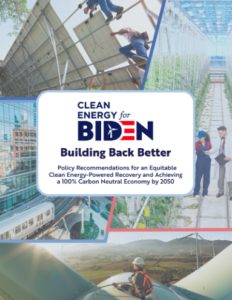Hydrogen Forward, as the United States pivots to clean energy policy
By Trevor Brown on February 12, 2021
At the start of this month, a coalition of eleven corporations launched a new advocacy body, Hydrogen Forward, with the explicit purpose of lobbying the United States government to pursue a national hydrogen strategy.
While Europe and East Asia have committed to investing hundreds of billions of dollars into hydrogen solutions, the U.S. is the only major market without a national hydrogen strategy. A comprehensive approach is critical because it provides a much-needed framework to enable fast, large-scale adoption.
Hydrogen Forward press release, “Hydrogen Forward” Coalition Formed to Advance Hydrogen in the U.S., February 2, 2021
Of the eleven founding members of Hydrogen Forward, five are also members of the Ammonia Energy Association — Air Liquide, CF Industries, Cummins, Linde, and Shell — demonstrating the interconnection between ammonia and hydrogen.
This announcement came two weeks after President Biden, on his first day in office, rejoined the Paris Agreement and restored the use of “science to tackle the climate crisis.” These executive actions are now clearly reflected in a profound shift that is visible all across the United States. (Even General Motors has committed to phase out all sales of gasoline-fueled cars by 2035, and aired an advertisement during last weekend’s SuperBowl seeking to compete with Norway for EV sales.)
While the US Department of Energy has achieved many successes in recent years within its “H2@Scale” initiative, now is clearly the time for significantly greater federal ambition and investment, and a hydrogen strategy for the United States would be a welcome development.
Accelerating investment in hydrogen will help the U.S. deliver on its climate goals while creating a stronger economy with new, good-paying jobs.
The initiative – which represents companies invested in all links of the hydrogen value chain from source to service – is focused on showcasing hydrogen’s unique value proposition among Washington, D.C. policymakers and other stakeholders to decisively accelerate adoption of hydrogen solutions and related infrastructure build-out across the nation.
Hydrogen Forward press release, “Hydrogen Forward” Coalition Formed to Advance Hydrogen in the U.S., February 2, 2021
A Hydrogen Strategy, and Production Tax Credits

At least one proposal for a national hydrogen strategy is, I promise, already on President Biden’s desk, along with recommendations for production tax credits for both hydrogen (and ammonia) production, as well as for electrolyzer manufacturing.
I recently co-authored a policy paper, as part of Clean Energy for Biden, that advocated for both a national “blueprint for hydrogen infrastructure” and a system of tax credits that would support scale-up of electrolyzer manufacturing, similar to the support for the wind and solar industries over recent years.
Opportunity/Problem:
Hydrogen can decarbonize industrial processes and electricity generation, will be instrumental in integrating energy sectors, and can be used to export abundant renewable energy from key states to the rest of the country and around the world. The US should rapidly scale up a national hydrogen industry, including demonstrating and manufacturing electrolyzers at industrial scale, to drive down costs and establish US leadership.Recommended Action(s):
Solomon Goldstein-Rose, Stephen Crolius, Abigail Regitsky, and Trevor Brown, Accelerating an American Industry for Clean Hydrogen Production (page 374), Clean Energy for Biden, Building Back Better, August 2020
• Create a Production Tax Credit for clean hydrogen and hydrogen carriers (such as ammonia) starting at $0.40-$2.00/kg, depending on the emissions intensity, phasing to zero over 10 years, for hydrogen produced in the US.
• Create a manufacturers’ Production Tax Credit of $500 per kW of capacity for American-manufactured electrolyzers.
• Provide Federal leadership for infrastructure planning and construction, by immediately convening a commission to develop a blueprint for hydrogen infrastructure, and by promoting demonstration of technologies and creating additional demand-pull policies.
The Social Cost of Carbon
I’ll conclude by talking about a very boring and very important number.
The second of President Biden’s Executive Orders, linked above, contains many details, including the revocation of permits for the Keystone Pipeline, but one of the most significant policy levers is the re-establishment of a Social Cost of Carbon. This is an input to the cost-benefit analysis behind federal policy decisions. This cost was set at $21 per ton when it was first established in 2009, rose to $52 by 2017, but has been flatlined at $1 per ton for the last four years.
While this is not a carbon tax, it is a cost that federal agencies must consider when developing policy — and it is now moving beyond carbon to include NOx and methane.
The “social cost of carbon” (SCC), “social cost of nitrous oxide” (SCN), and “social cost of methane” (SCM) are estimates of the monetized damages associated with incremental increases in greenhouse gas emissions. They are intended to include changes in net agricultural productivity, human health, property damage from increased flood risk, and the value of ecosystem services …
The Working Group shall … publish an interim SCC, SCN, and SCM within 30 days of the date of this order, which agencies shall use when monetizing the value of changes in greenhouse gas emissions resulting from regulations and other relevant agency actions …
The White House, Executive Order on Protecting Public Health and the Environment and Restoring Science to Tackle the Climate Crisis, January 20, 2021
Since we relaunched the Ammonia Energy Association in 2018, we have described ourselves as a global organization based in the United States. It seems like, now, there might be some real value in developing domestic policy. If nothing else, the United States can still try to catch up.